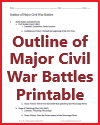 |
| Unit VII: Civil War and Reconstruction Outlines and PowerPoints |
|---|
| www.studenthandouts.com ↣ U.S. History ↣ Civil War ↣ Civil War Outlines and PowerPoints |
 | ||||||||||
| Outline of Major Civil War Battles Printable |
|
Outlines can be highly beneficial tools for students of American History when studying the Civil War and Reconstruction. They help students organize complex historical events, identify key themes and developments, and gain a structured understanding of this pivotal period in American history. Here is how outlines can aid in the comprehension of the Civil War and Reconstruction. Structured Overview: Outlines provide a structured overview of the major events, dates, and key figures during the Civil War and Reconstruction. This visual organization helps students grasp the chronology and flow of historical events. Focus on Key Themes: Outlines can highlight key thematic elements of the Civil War and Reconstruction, such as slavery, states' rights, abolition, emancipation, and the challenges of Reconstruction. This thematic focus allows students to delve deeper into critical issues. Cause and Effect Relationships: Outlines can illustrate the cause-and-effect relationships between events leading up to the Civil War, the war itself, and the consequences of Reconstruction. This helps students understand the interconnectedness of historical developments. Identification of Key Figures: Outlines often include the names and roles of important historical figures, both political and military leaders, who played pivotal roles during this period. This aids in recognizing the individuals who shaped the era. Highlighting Battles and Campaigns: For the Civil War, outlines can specify significant battles, campaigns, and their outcomes. Students can understand the military strategies and turning points of the conflict. Legal and Political Changes: Outlines can emphasize the legal and political changes brought about by the Civil War and Reconstruction, including the Emancipation Proclamation, the 13th, 14th, and 15th Amendments, and the Reconstruction Acts. Social and Cultural Shifts: Outlines may address social and cultural shifts during Reconstruction, such as the changing status of formerly enslaved people, the rise of the Ku Klux Klan, and the evolving role of women. Regional Differences: Outlines can help students understand the contrasting experiences and perspectives of the North and the South during and after the war, including economic, social, and political differences. Review and Study Aid: Outlines serve as excellent review and study tools, allowing students to condense large amounts of information into manageable sections for exam preparation and essay writing. Visual Organization: The visual structure of outlines, with indentations, bullet points, and hierarchies, aids in the visual organization of information, making it easier for students to follow the flow of historical events. Critical Thinking: Outlines encourage students to think critically about the historical narrative, its causes, consequences, and significance. They can use outlines as starting points for deeper research and analysis. Outlines provide a valuable framework for students to comprehend the complex events, people, and themes of the Civil War and Reconstruction. They serve as a guide for organizing knowledge, identifying key details, and promoting a deeper understanding of this transformative period in American history. |
| www.studenthandouts.com ↣ U.S. History ↣ Civil War ↣ Civil War Outlines and PowerPoints |








